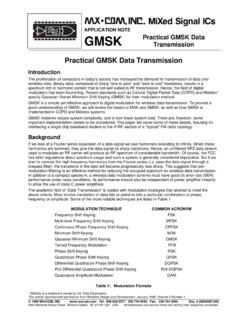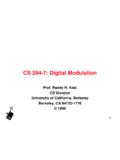Transcription of GAUSSIAN MINIMUM SHIFT KEYING (GMSK) - Rutvij C
1 GAUSSIAN MINIMUM . SHIFT KEYING . ( gmsk ). Shaishav Parmar 1 (SPC), 1st Sem ADIT, New Nagar GOAL OF TODAY'S LECTURE. | Introduction to gmsk . | Overview of MSK . | Generation of gmsk & its Waveform. | Pulse shaping. | Summing , Integration , I & Q signals. | gmsk Receiver | Power spectrum of gmsk . | Properties. | Advantages. | Disadvantages. | Applications. 2. Shaishav Parmar INTRODUCTION TO gmsk . | GAUSSIAN MINIMUM SHIFT KEYING ( gmsk ) is a form of continuous-phase FSK in which the phase change is changed between symbols to provide a constant envelope. Consequently it is a popular alternative to QPSK. | The RF bandwidth is controlled by the GAUSSIAN low-pass filter. The degree of filtering is expressed by multiplying the filter 3dB bandwidth (B) by the bit period of the transmission (T), by BT (BT =.)
2 For GSM networks) . | gmsk allows efficient class C non-linear amplifiers to be used. 3. Shaishav Parmar INTRODUCTION TO gmsk . (CONT .). | GAUSSIAN MINIMUM SHIFT KEYING . | Modulation scheme used in GSM. | Bandwidth-time product. y Describes the amount the symbols overlap y BT = for GSM networks y Good spectral efficiency y At the expense of some inter-symbol interference (ISI). | Data rate: kbps. 4. Shaishav Parmar MSK. | gmsk is based on MSK. | MINIMUM SHIFT KEYING . y Linear phase changes y Spectrally efficient | At baseband, bit transitions are represented by . sinusoidal cycle. 5. Shaishav Parmar GENERATION OF gmsk . | It is similar to standard MINIMUM - SHIFT KEYING (MSK);. however the digital data stream is first shaped with a GAUSSIAN filter before being applied to a frequency modulator.
3 | This has the advantage of reducing sideband power, which in turn reduces out-of-band interference between signal carriers in adjacent frequency channels. | However, the GAUSSIAN filter increases the modulation memory in the system and causes intersymbol interference, making it more difficult to discriminate between different transmitted data values and requiring more complex channel equalization algorithms such as an adaptive equalizer at the receiver. 6. Shaishav Parmar GENERATING A gmsk . WAVEFORM. GAUSSIAN gmsk . NRZ FM. Low Pass Output at RF. Data transmitter Filter HGf = exp (- 2f2). Where , <=> B = 3 dB Bandwidth = F = frequency in Hz. | gmsk as implemented by quadrature signal processing at baseband followed by a quadrature modulator 7.
4 Shaishav Parmar GENERATING A gmsk WAVEFORM. (CONT .). | gmsk as implemented by quadrature signal processing at baseband followed by a quadrature modulator 8. Shaishav Parmar PULSE SHAPING. | Input: Binary pulse train (+1/-1). | Each binary pulse goes through a LPF with a GAUSSIAN impulse response. y The filter smoothes the binary pulses y The filter output is truncated and scaled | This process results in a train of GAUSSIAN shaped pulses 9.. Shaishav Parmar SUMMING AND INTEGRATION. | The pulses are summed together (left). | The signal is integrated over time to obtain a continuous waveform which captures the bit transition information (right). 10. Shaishav Parmar I&Q SIGNALS. | The resulting waveform is divided into In-Phase and Quadrature components.
5 Y In-phase: Left y Quadrature: Right | The two signal components are then up-converted to the carrier frequency. 11. Shaishav Parmar gmsk RECEIVER. | Two D flip-flops acts as a quadrature product demodulator generate mutually orthogonal ref careers. | X-OR gates acts as a baseband multipliers. 12. Shaishav Parmar gmsk PROPERTIES. | Improved spectral efficiency. | Power Spectral Density. y Reduced main lobe over MSK. | Requires more power to transmit data than many comparable modulation schemes. | Self synchronizing capability | Constant envelope over entire | Good BER performance 13. Shaishav Parmar POWER SPECTRUM OF. gmsk . BT Decreases , side lobe falls rapidly. increases irreducible error rate. Gives more power (%) with BT.
6 Of = BT of MSK. 14. Shaishav Parmar gmsk BIT ERROR RATE. | Function of BT. | Bit error probability for gmsk is 15. Shaishav Parmar ADVANTAGES. | High spectral efficiency. | Reducing sideband power. | Excellent power efficiency due to constant envelope. | Good choice for voice modulation. 16. Shaishav Parmar DISADVANTAGES. | Higher power level than QPSK. | Requiring more complex channel equalization algorithms such as an adaptive equalizer at the receiver. 17. Shaishav Parmar APPLICATION. | Most widely used in the Global System for Mobile Communications (GSM). | Used for CDPD (cellular digital packet data) overlay network. | Used for GPRS & EDGE systems. 18. Shaishav Parmar REFERENCES. | Rappaport TS. Wireless Communications, Prentice Hall PTR.
7 | Proakis J. Digital Communications, McGraw & Hill Int. | Fitton M. Principles of Digital Modulation, | Ke-Lin Du & Wireless Communication Systems, Cambridge University Press 19. Shaishav Parmar Thank You Shaishav Parmar 20.






